paul revere
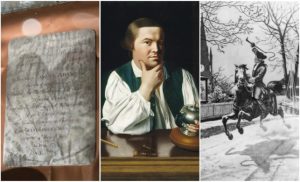 So often the past is lost because it was not preserved somehow, whether by writings, word of mouth, or in rare times it is preserved because someone put things in a time capsule to be opened at a later date. Most of us think of time capsules as a fairly modern concept, but they really aren’t. A few years ago, Massachusetts Governor Deval Patrick and other dignitaries were on hand to witness the opening of one of the nation’s oldest time capsules, located in the Art of the Americas wing at the Boston Museum of Fine Arts. The date was January 6, 2015. The museum’s conservator, Pam Hatchfield removed the screws from the corners of the brass box and carefully extracted its contents using tools including a porcupine quill and a dental pick that belonged to her grandfather.
So often the past is lost because it was not preserved somehow, whether by writings, word of mouth, or in rare times it is preserved because someone put things in a time capsule to be opened at a later date. Most of us think of time capsules as a fairly modern concept, but they really aren’t. A few years ago, Massachusetts Governor Deval Patrick and other dignitaries were on hand to witness the opening of one of the nation’s oldest time capsules, located in the Art of the Americas wing at the Boston Museum of Fine Arts. The date was January 6, 2015. The museum’s conservator, Pam Hatchfield removed the screws from the corners of the brass box and carefully extracted its contents using tools including a porcupine quill and a dental pick that belonged to her grandfather.
In December, Hatchfield had spent nearly seven hours extracting the time capsule from the cornerstone of the Massachusetts State House. The event brought with it an electrical feeling of excitement. The brass box, now green with age, measured 5.5 by 7.5 by 1.5 inches, which is a little smaller than a cigar box. It weighed 10 pounds. The contents of the time capsule were not a complete surprise, because the original time capsule had been removed in 1855, during some repairs to the building. At that time, its contents were cleaned and documented before it was placed back in the cornerstone.
More recently, workers fixing a leak unearthed the time capsule that had been placed in the building’s cornerstone more than two centuries earlier. But even after X-raying and examining the box, Hatchfield and her colleagues had no way of knowing what kind of condition the ancient contents would be in, nor did they have any idea of what was inside. The first items removed from the time capsule were folded newspapers. They 
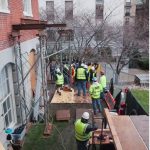 were in “amazingly good condition” according to Hatchfield. There were five newspapers all, including copies of the Boston Bee and Boston Traveler. Next they removed 23 coins, in denominations of half-cent (something modern people haven’t heard of), penny, quarter, dime and half-dime (Isn’t that a nickel? I guess it hadn’t been named yet). Some of the coins dated back to the mid-19th century, but some were from 1795. There was also a so-called “Pine Tree Shilling” dated to 1652. Just the coins alone are an amazing find, but they wouldn’t be proof of who had placed them in the box. The box also contained a copper medal with George Washington’s image and the words “General of the American Army,” a seal of the Commonwealth of Massachusetts, and a title page from the Massachusetts Colony Records. There was no clear indication of who it had belonged to. Finally, Hatchfield removed a silver plate with fingerprints still on it, bearing an inscription dedicating the State House cornerstone on the 20th anniversary of American independence in July 1795. While the silver plate is amazing, to me, the fingerprints are a stellar find.
were in “amazingly good condition” according to Hatchfield. There were five newspapers all, including copies of the Boston Bee and Boston Traveler. Next they removed 23 coins, in denominations of half-cent (something modern people haven’t heard of), penny, quarter, dime and half-dime (Isn’t that a nickel? I guess it hadn’t been named yet). Some of the coins dated back to the mid-19th century, but some were from 1795. There was also a so-called “Pine Tree Shilling” dated to 1652. Just the coins alone are an amazing find, but they wouldn’t be proof of who had placed them in the box. The box also contained a copper medal with George Washington’s image and the words “General of the American Army,” a seal of the Commonwealth of Massachusetts, and a title page from the Massachusetts Colony Records. There was no clear indication of who it had belonged to. Finally, Hatchfield removed a silver plate with fingerprints still on it, bearing an inscription dedicating the State House cornerstone on the 20th anniversary of American independence in July 1795. While the silver plate is amazing, to me, the fingerprints are a stellar find.
“This cornerstone of a building intended for the use of the legislative and executive branches of the government of the Commonwealth of Massachusetts was laid by his Excellency Samuel Adams, Esquire, governor of the said Commonwealth,” Michael Comeau, executive director of the Massachusetts Archives, read from the plate’s inscription to the assembled crowd, adding “How cool is that.” It is believed that the plate was the work of Paul Revere, the master metalsmith and engraver turned Revolutionary hero who placed the time capsule alongside Adams and William Scollay, a colonel in the Revolutionary War. It took nearly an hour to remove all the items from the time capsule. I’m sure they wanted to be both careful, and also have a really good look at them. The 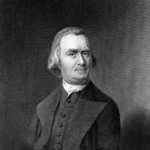

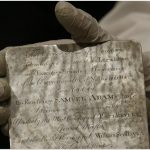 museum’s conservators then began the work on preserving the contents so they could be put on display. According to the Massachusetts Secretary of State, William Galvin, the time capsule will eventually be returned to the cornerstone, but it’s not certain whether state officials will add any new objects to it before burying it again.
museum’s conservators then began the work on preserving the contents so they could be put on display. According to the Massachusetts Secretary of State, William Galvin, the time capsule will eventually be returned to the cornerstone, but it’s not certain whether state officials will add any new objects to it before burying it again.
 When the United States was first trying to become a sovereign nation, due to the unfair treatment it received from its parent nation, Great Britain, King George III’s army tried to stop it in any way they could. I’m sure the king could see the possibilities this nation had, and I’m also sure he could see the writing on the wall concerning our independence. Still, the king said to fight, so fight they did. The people in the colonies thought the king’s rule was tyrannical and infringed on the colonists’ “rights as Englishmen”, and so they declared the colonies were going to be free and independent states. A war ensued, that we know as the Revolutionary War.
When the United States was first trying to become a sovereign nation, due to the unfair treatment it received from its parent nation, Great Britain, King George III’s army tried to stop it in any way they could. I’m sure the king could see the possibilities this nation had, and I’m also sure he could see the writing on the wall concerning our independence. Still, the king said to fight, so fight they did. The people in the colonies thought the king’s rule was tyrannical and infringed on the colonists’ “rights as Englishmen”, and so they declared the colonies were going to be free and independent states. A war ensued, that we know as the Revolutionary War.
On April 7, 1775, British activity suggested the possibility of troop movements, and Dr Joseph Warren, an American physician who played a leading role in American Patriot organizations in Boston in the early days of the American Revolution, sent Paul Revere to warn the Massachusetts Provincial Congress, which was located in Concorde. This was also the site of one of the larger caches of Patriot military supplies. The warning spurred the residents into action…moving the military supplies away from the town. Just one week later, on April 14, General Gage received instructions from Secretary of State William Legge, Earl of Dartmouth. The orders had been dispatched on January 27. The British soldiers were told to disarm the rebels. It was known that they often hid weapons in Concord, as well as other locations. They were told to imprison the rebellion’s leaders, especially Samuel Adams and John Hancock. Dartmouth gave Gage considerable discretion in his commands. Gage issued orders to Lieutenant Colonel Francis Smith to proceed from Boston “with utmost expedition and secrecy to Concord, where you will seize and destroy… all Military stores…. But you will take care that the soldiers do not plunder the inhabitants or hurt private property.” Gage did not issue written orders for the arrest of rebel leaders, because he was afraid that doing so might spark an uprising.
On the night of April 18, 1775, with tensions rising, Joseph Warren went to see Revere and William Dawes. He told them that the king’s troops were about to embark in boats from Boston bound for Cambridge, as well as the road to Lexington and Concord. Warren’s intelligence suggested that the most likely objectives of the 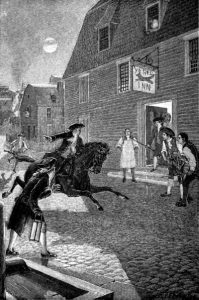 regulars’ movements later that night would be the capture of Adams and Hancock. They did not worry about the possibility of regulars marching to Concord, since the supplies at Concord were safe, but they did think their leaders in Lexington were unaware of the potential danger that night. Revere and Dawes were sent out to warn them and to alert colonial militias in nearby towns. Prior to this time, Revere had instructed Robert Newman, the sexton of the North Church, to send a signal by lantern to alert colonists in Charlestown as to the movements of the troops when the information became known. In what is well known today by the phrase “one if by land, two if by sea”, one lantern in the steeple would signal the army’s choice of the land route while two lanterns would signal the route “by water” across the Charles River. The British would ultimately take the water route, so two lanterns were placed in the steeple. Revere first gave instructions to send the signal to Charlestown. He then crossed the Charles River by rowboat, slipping past the British warship HMS Somerset at anchor. Crossings were banned at that hour, but Revere safely landed in Charlestown and rode to Lexington, avoiding a British patrol and later warning almost every house along the route. The Charlestown colonists dispatched additional riders to the north. Riding through present-day Somerville, Medford, and Arlington, Revere warned patriots along his route, many of whom set out on horseback to deliver warnings of their own. By the end of the night there were probably as many as 40 riders throughout Middlesex County carrying the news of the army’s advance. Revere did not shout the phrase “The British are coming!” The success of his mission depended on secrecy, and the countryside was filled with British army patrols, and most of the Massachusetts colonists, who were predominantly English loyalists. Revere’s warning, according to eyewitness accounts of the ride and Revere’s own descriptions, was “The Regulars are coming out.” Revere arrived in Lexington around midnight, with Dawes arriving about a ½ hour later. They met with Samuel Adams and John Hancock, spending a great deal of time discussing plans of action. They believed that the forces leaving the city were too large for the sole purpose of arresting two men and that Concord was the main target. The Lexington men dispatched riders to the surrounding towns, and Revere and Dawes continued along the road to Concord accompanied by Samuel Prescott, a doctor who happened to be in Lexington. Revere, Dawes, and Prescott were detained by a British Army patrol in Lincoln at a roadblock on the way to Concord. Prescott jumped his horse over a wall and escaped into the woods. He eventually reached Concord. Dawes also escaped, but fell off his horse not long after and did not complete the ride. After being roughly questioned for an hour or two, Revere was released when the patrol heard Minutemen alarm guns being fired on their approach to Lexington.
regulars’ movements later that night would be the capture of Adams and Hancock. They did not worry about the possibility of regulars marching to Concord, since the supplies at Concord were safe, but they did think their leaders in Lexington were unaware of the potential danger that night. Revere and Dawes were sent out to warn them and to alert colonial militias in nearby towns. Prior to this time, Revere had instructed Robert Newman, the sexton of the North Church, to send a signal by lantern to alert colonists in Charlestown as to the movements of the troops when the information became known. In what is well known today by the phrase “one if by land, two if by sea”, one lantern in the steeple would signal the army’s choice of the land route while two lanterns would signal the route “by water” across the Charles River. The British would ultimately take the water route, so two lanterns were placed in the steeple. Revere first gave instructions to send the signal to Charlestown. He then crossed the Charles River by rowboat, slipping past the British warship HMS Somerset at anchor. Crossings were banned at that hour, but Revere safely landed in Charlestown and rode to Lexington, avoiding a British patrol and later warning almost every house along the route. The Charlestown colonists dispatched additional riders to the north. Riding through present-day Somerville, Medford, and Arlington, Revere warned patriots along his route, many of whom set out on horseback to deliver warnings of their own. By the end of the night there were probably as many as 40 riders throughout Middlesex County carrying the news of the army’s advance. Revere did not shout the phrase “The British are coming!” The success of his mission depended on secrecy, and the countryside was filled with British army patrols, and most of the Massachusetts colonists, who were predominantly English loyalists. Revere’s warning, according to eyewitness accounts of the ride and Revere’s own descriptions, was “The Regulars are coming out.” Revere arrived in Lexington around midnight, with Dawes arriving about a ½ hour later. They met with Samuel Adams and John Hancock, spending a great deal of time discussing plans of action. They believed that the forces leaving the city were too large for the sole purpose of arresting two men and that Concord was the main target. The Lexington men dispatched riders to the surrounding towns, and Revere and Dawes continued along the road to Concord accompanied by Samuel Prescott, a doctor who happened to be in Lexington. Revere, Dawes, and Prescott were detained by a British Army patrol in Lincoln at a roadblock on the way to Concord. Prescott jumped his horse over a wall and escaped into the woods. He eventually reached Concord. Dawes also escaped, but fell off his horse not long after and did not complete the ride. After being roughly questioned for an hour or two, Revere was released when the patrol heard Minutemen alarm guns being fired on their approach to Lexington.
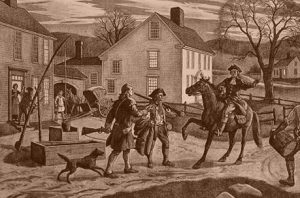
About 5am on April 19, 700 British troops under Major John Pitcairn arrived at the town to find a 77 man strong colonial militia under Captain John Parker waiting for them on Lexington’s common green. Pitcairn ordered the outnumbered Patriots to disperse, and after a moment’s hesitation, the Americans began to drift off the green. Suddenly, the “shot heard around the world” was fired from an undetermined gun, and a cloud of musket smoke soon covered the green. When the brief Battle of Lexington ended, eight Americans lay dead and 10 others were wounded Only one British soldier was injured. The American Revolution had begun.

